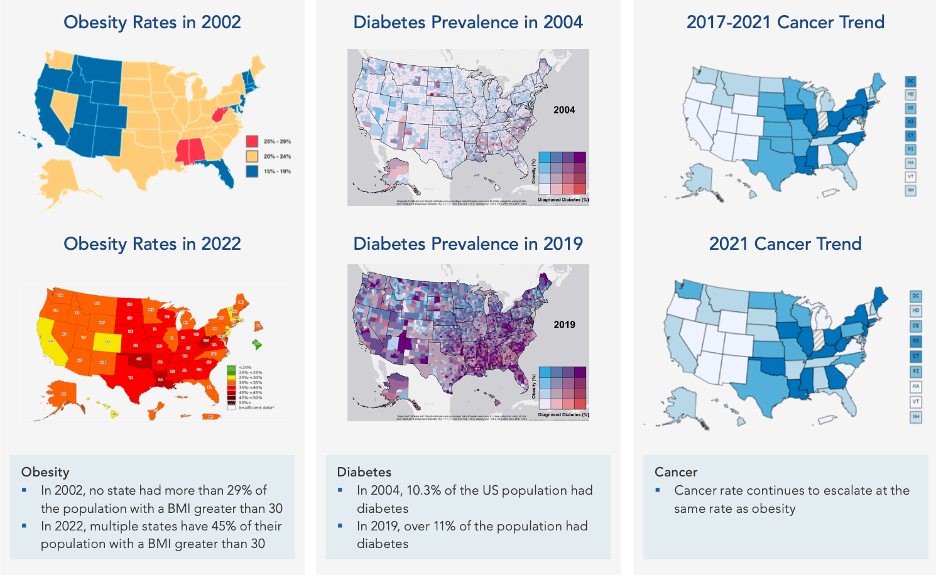I had my first colonoscopy last week, and I’m pleased to report that I’m polyp-free! 1
Several people asked why I got screened so early. “Aren’t you too young?” some said. Others asked, “Does colon cancer run in your family?” While neither applied, I chose to follow my doctor’s advice for a simple reason: I didn’t expect to see so many people my age (and younger) getting diagnosed with chronic illnesses we used to think were ‘later in life’ problems. The more I learn, the more I realize we can’t afford to wait. Like an iceberg, the biggest health threats often lie beneath the surface. The good news? We know what’s driving these trends and we have more tools than ever to address them.
Why Oral Health Is a Mirror of Overall Health
At Empowering Smiles, we believe whole-body health starts at the top—literally.
Let me tell you about a recent patient. She walked into the operatory: visibly obese, dark circles under her eyes, and a history of thyroid disease.
During our first 10 minutes together, I noticed she had:
- A large tongue and enlarged tonsils that were obstructing the back of her throat
- Two rounds of orthodontics (braces)
- Sleep apnea (which she wasn’t treating)
- Severe gum inflammation and bleeding – despite daily brushing and flossing
- Heavy tartar buildup
I encouraged her to get screened for diabetes and to appeal her denied insurance claim to pay for treatment to manage her sleep apnea. Her profile – a mix of obesity, untreated sleep issues, and periodontal disease – represents a major risk stack for chronic diseases, including cancer. And we uncovered all of this in one dental visit!
The Rising Tide of Obesity, Diabetes, and Cancer

Image Credit: USI Employee Benefits Market Outlook 2025
I’m about to throw some stats your way, not to make you feel hopeless, but to help you see why it’s time to wake up and take action!
From 1999 to 2019, new cancer cases rose by 29%. Even more concerning, colon cancer is now the leading cancer diagnosis for people ages 20–29 and diagnoses in people under 55 have doubled over the last 30 years.
Early detection matters. Catching cancer at Stage 0 or 1 can cost an estimated $60,000 to $100,000 per person, per year, while late-stage treatment (Stages 3 or 4) can cost two to three times more.
What’s Driving This Trend?
While many factors contribute to cancer risk, obesity and poor diet are two of the most influential.
Take endometrial cancer, for example. Endometrial cancer is a cancer of the lining of the uterus that primarily affects postmenopausal women. Of all the cancers known, it has the strongest relationship with obesity – 50% of all endometrial cancers can be attributed to being obese. This is likely related to hormonal imbalances caused by excess body fat.
Obesity: A National Crisis
In 2002, no U.S. state had an obesity rate above 29%. Fast forward to 2022, and many states have rates over 45%. Currently, more than one in five adults in every U.S. state is obese. (If you would like to calculate your BMI click here.)
Obesity isn’t just a number on the scale—it’s expensive. The medical costs associated with obesity total around $173 billion annually, with an additional $3.4 to $6.4 billion lost to obesity-related absenteeism.
Obesity is also a gateway to other chronic conditions:
- Type 2 diabetes,
- Heart disease,
- Depression,
- And yes—cancer.
By 2030, 40% of the U.S. population could be considered obese. Not chubby, not overweight – obese.
What the Microbiome Has to Do with It
Here’s something fascinating: obese women tend to have a gut microbiome similar to women who have caner, whether they are lean or obese 2.
Research suggests that protective bacteria, like Lactobacillus may play a role in cancer defense. If obesity is driving microbial imbalance, we may see microbiota transplants become a routine part of future cancer therapies.
Diabetes: Costly and Climbing
Today, 38.4 million Americans—or 11.6% of the population—have diabetes. Every year, 1.2 million more are diagnosed. More than 90% of diabetes cases are type 2 diabetes, which can be prevented through lifestyle changes.
It’s not just a health burden; it’s a financial one. Poorly managed diabetes leads to complications (kidney failure, foot ulcers, stroke, heart attack, vision loss, and many more) that triple healthcare costs.
A Few Things That Can Move the Needle
I know this all sounds heavy, and honestly, it is. But here’s the good news: we aren’t powerless. Even small steps, taken consistently, can shift your health in a big way over time.
Here are a few places to start:
Eat more whole foods. You don’t need to overhaul your whole life. Just crowd out the junk with more fiber, more color, more real food. Your gut (and your immune system) will thank you. Speaking of kids and food, yesterday at our pool party weI had seven kids in the pool aged 3 to 11, and all of them were begging for some gummy worms. So what did I do? Each kid had to eat a stalk of celery for some gummy worms. (All but one kid rolled with it.) I’m not saying celery cancels out the candy, but it made me feel better knowing a fibrous veggie like celery would at least help clean the sticky treat from their teeth.
Prioritize sleep and address poor sleep quality. This is something I’m personally working on, but more on me later. Undiagnosed sleep apnea, mouth breathing, and poor-quality sleep quietly fuel inflammation, hormone imbalance, and disease risk. If you snore, wake up tired, or grind your teeth – get screened.
Treat your mouth like part of your body. Because it is! Bleeding gums, dry mouth, bad breath – these are clues. Oral health is systemic health so if your dental professional doesn’t bring it up, you can. Your health is your responsibility and you deserve to understand it.
Get your screenings. Whether it’s a colonoscopy, A1c, oral health scan, or sleep study, don’t skip the tests that give you insight into what’s going on below the surface. Prevention is powerful.
The Empowering Smiles Approach
At Empowering Smiles, we go far beyond brushing tips. We help clients uncover hidden risks using:
- Oral imaging and analysis
- Microbiome-based risk assessments
- Coaching based on science – not fear
Because what’s happening in your mouth might be the earliest warning sign of what’s happening in your body.
Want to feel more in control of your health?
Explore our programs or schedule a call to see how your mouth could be the key to better health.

